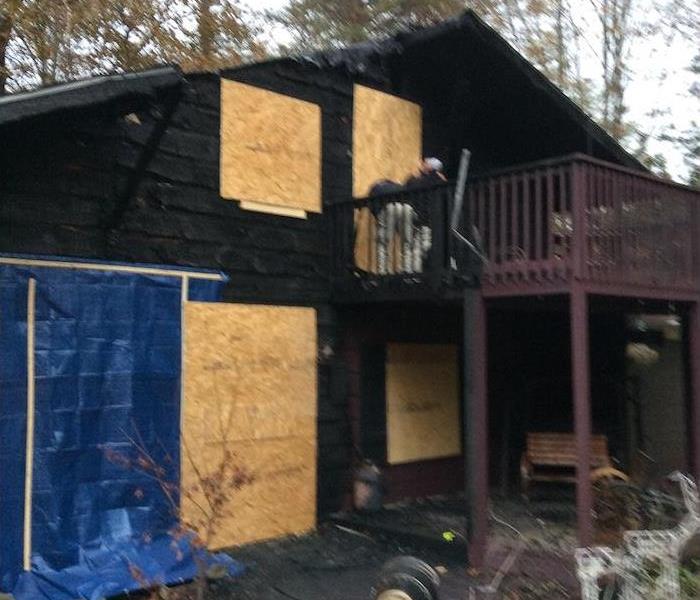How Can Soot Get Removed from My Pigeon Forge Home?
8/31/2020 (Permalink)
Depending on its location and the materials affected, soot can be a considerable threat to your property if not addressed quickly and deliberately.
Fire restoration and recovery can be an overwhelming process for Pigeon Forge homeowners. Seeing your property in such disarray after a structure fire can leave you questioning whether the house will ever look the same again. As a trusted restoration company for many insurance providers serving our area, we understand all of the obstacles we could face with your home's restoration and recovery. We work alongside your insurance adjuster to meet their expectations, needs, and limitations. In many ways, beginning as soon as our team first arrives, we are working to make fire losses, "Like it never even happened."
Among the most threatening conditions that exist after fire damage in Pigeon Forge homes are smoke residues and soot. These residues and circulating particles can be hazardous to the health of those exposed and provide a threat to the surfaces where these particulates come to rest. Addressing these concerns requires multiple strategies, equipment, and even qualified personnel.
How Does Soot Develop?
Despite the destruction you might see looking around your house after a fire gets extinguished, much of what you view is incomplete combustion. Half-burned materials and contents can often be a catalyst for soot production and smoke residues adhering to the walls, ceilings, and other surfaces throughout the house. Soot can be among the most dangerous and threatening presences in your home after a fire, specifically because of its effect on those exposed without the appropriate personal protective equipment. Our technicians responding to fire loss incidents arrive with respirators, coveralls, and other protective gear to ensure that we are not directly exposed to hazardous conditions until the property's appropriate evaluation has taken place. With soot concerns, the primary threatening aspects of this health hazard include:
- Microscopic size
- Carcinogenic
- Acidic
How Can You Remove Smoke Residues from Wall and Ceiling Surfaces?
Our responding technicians' primary focus is to address smoke residues adhered to services throughout your property. The faster that we can remove these safely, the less threat of our technicians or the occupants of the house becoming exposed to threatening conditions. Also, our focus on eliminating soot buildup on the services of specific materials and wall systems can protect these materials from the particles' acidic nature. There are many factors involved in choosing the right approach for removing smoke residues, including the type of residue present, the thickness of the coating, the material underneath the residue, and other factors. Specific abrasive cleaning techniques could damage underlying materials if these considerations do not happen before cleaning begins. Among the popular choices for residue removal, we often consider:
- Media Blasting – The premise of blasting involves using media like baking soda and pressurized water or air to dislodge and remove smoke residues from exposed materials' surfaces. This approach can impact the coating of soot exclusively without damaging the underlying substrate.
- Dry Ice Blasting - Pressurized dry ice pellets (CO2) are placed in a hopper and then directed at slightly charred roof members to scrape off a thin layer of carbonized wood. This means that supporting structures, especially for the roof, do not require demolition.
- Surface Cleaning – Oily residues like you might find after proteins have burned, can be equally challenging to remove from specific surfaces. Emulsification is the best approach in these situations, and this occurs by introducing water-based solvents to the surfaces along with abrasive cleaning techniques.
- Controlled Demolition – In more extreme cases where so the damage has already impacted the material to the point of degradation or staining, the suitable approach is to remove the affected portions of the construction material. Addressing the situation quickly can reduce a greater need for tear-out and reconstruction overall.
Can Soot Get Removed from Contents?
Protecting your personal belongings is also a focal point of our fast response to fire emergencies. Soot can be just as considerable of a threat to these possessions as it is to services throughout the home. In many situations, it is cost-effective and more efficient to relocate these damaged belongings to our SERVPRO facility for focused cleaning and restoration. We have several specific techniques designed exclusively to address smoke residues within varying materials. Some of these approaches include:
- Surface cleaning
- ESPORTA Wash System
- Immersion tank soot removal
Removing smoke residues requires specific equipment, products, and experienced personnel to achieve. You can count on the fast response and industry-leading equipment of our SERVPRO of Sevier, Jefferson & Cocke Counties team when fire emergencies occur. Give us a call whenever you need us at (865) 429-8885.






 24/7 Emergency Service
24/7 Emergency Service
